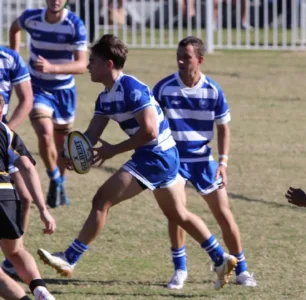Rugby, a sport renowned for its raw power and strategic finesse, is a thrilling battleground where players strive to outmaneuver their opponents. Among the myriad techniques that have shaped rugby’s evolution, the goose step stands out as a dazzling spectacle that epitomizes agility and deception. In this article, we delve into the captivating world of the goose step in rugby, tracing its roots, dissecting its execution, and exploring its contemporary significance.
Origins and Evolution
The goose step, an artful sidestep maneuver, traces its origins to the realm of military drills. Derived from the distinctive marching style of soldiers, this technique was first introduced to rugby in the early 20th century. Its initial purpose was to baffle defenders by creating an illusion of movement, thereby allowing the ball carrier to break through the opposition’s defensive line.
Incorporating a goose step into rugby required a blend of audacity and inventiveness. The player executing the maneuver plants one foot while extending the other leg fully, lifting it high in the air. This graceful yet deceptive motion confounds opponents, making it challenging to predict the direction in which the ball carrier will move next.
The Mesmerizing Execution
Executing a perfect goose step demands a fusion of physical prowess, mental acuity, and split-second decision-making. As the ball carrier advances towards the opposition, a seamless transition into the goose step involves three crucial phases:
- Planting the Pivot: The ball carrier’s pivot foot is firmly planted on the ground, acting as the axis around which the sidestep revolves. This foot provides stability, allowing the player to channel energy into the subsequent movements.
- Elevation: The non-pivot leg is raised high, creating an illusion of motion. This elevation serves a dual purpose: baffling opponents by creating uncertainty about the player’s next move and positioning the body for a rapid change in direction.
- Deceptive Movement: With the opposition momentarily off balance, the ball carrier swiftly shifts their weight to the elevated leg. This propels them into a sidestep, exploiting the defender’s uncertainty and creating space to surge forward.
Mastering the Art
The goose step isn’t merely a flashy show of agility; it demands rigorous practice and innate understanding of opponents’ behavior. Players aiming to master this technique invest countless hours in refining their balance, timing, and spatial awareness.
1. Balance and Coordination: Maintaining equilibrium during the elevation phase is crucial. Players must strike a delicate equilibrium between lifting the leg high and not losing control. This balance ensures a seamless transition into the sidestep, enabling rapid changes in direction.
2. Timing Precision: Timing is the crux of the goose step. Executing it too early or too late can jeopardize its effectiveness. Mastering the art of reading defenders’ movements and identifying the opportune moment to initiate the sidestep is a hallmark of skilled players.
3. Psychological Warfare: The goose step isn’t just a physical maneuver; it’s a psychological one too. Successfully deploying it instills doubt in the minds of defenders, who are left grappling with uncertainty about the player’s intentions.
Impact on Modern Gameplay
In the contemporary landscape of rugby, the goose step remains a potent weapon in a player’s arsenal. Its ability to confound defenders and create openings in the opposition’s defense makes it a game-changer in critical moments. The goose step has evolved beyond a mere sidestep; it’s a tactical choice that can shift the momentum of an entire match.
Mind Games and Strategic Decisions
Rugby is as much a mental game as a physical one, and the goose step exemplifies this truth. When a player executes a goose step, it sets off a chain reaction of uncertainty within the opposition’s ranks. Defenders are forced to second-guess their positioning, potentially creating gaps in their defense.
Coaches and players alike recognize the goose step’s potential as a strategic weapon. Its deceptive nature can force the opposition to commit prematurely to defending a particular direction, only for the ball carrier to swiftly change course. This calculated psychological warfare often leads to opportunities for line breaks and subsequent tries.
Revolutionizing Attack Dynamics
Modern rugby has seen a transformation in attacking strategies, and the goose step plays a pivotal role in this evolution. Traditionally, rugby was characterized by direct physical confrontations and power plays. However, with the emergence of skillful and agile players, the goose step has become an essential tool for breaking defensive lines.
By incorporating the goose step into their arsenal, attacking players bring an unpredictable dimension to their team’s offensive tactics. The sidestep’s effectiveness isn’t solely attributed to speed; it’s about the element of surprise and the ability to manipulate defenders’ perceptions.
Inspiring a New Generation
The mesmerizing allure of the goose step isn’t limited to the field – it has the power to captivate fans and aspiring players alike. Young rugby enthusiasts watch in awe as their idols effortlessly glide past defenders, and they aspire to replicate these feats on their own journey.
The goose step serves as an embodiment of the sport’s grace and dynamism. Its visual appeal and strategic significance make it an integral part of rugby’s narrative, inspiring young athletes to cultivate their agility, footwork, and mental acumen.
The Goose Step’s Cultural Resonance
Beyond its tactical implications, the goose step holds cultural significance in the rugby community. It has become emblematic of individual brilliance and the audacity to challenge conventions. Moments of a perfectly executed goose step are etched into rugby’s history, celebrated not only for their impact on the game but also for their sheer artistic beauty.
Conclusion
In the ever-evolving tapestry of rugby, the goose step remains an enduring symbol of innovation and finesse. From its origins as a military-inspired sidestep to its transformation into a psychological weapon, this technique has indelibly shaped the course of the game. As rugby continues to embrace new strategies and athletic prowess, the goose step will undoubtedly retain its position as one of the sport’s most captivating maneuvers.

